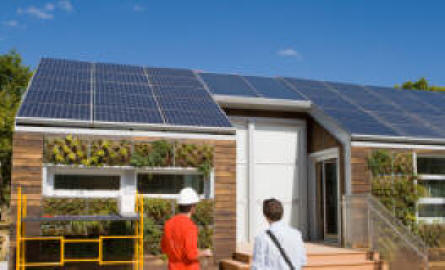|
Solar Cells: How they Work
If you've ever used a small solar-powered calculator, you have a
little understanding about how solar cells,
also called photovoltaics, work.
You may have played with your calculator at a young age, watching the
numbers on the screen disappear as you
covered with your thumb the small gray
squares on the face of the calculator.
Perhaps you even inadvertently lost some of your calculations by
accidentally obscuring contact with light
with your papers or books.

In any case, this same technology is now being researched on a much
larger scale, as scientists are trying to
harness the sun's powers for larger uses,
such as to provide electricity to homes and
businesses.
Solar cells work by gathering the
sun's rays in a material that is similar
to that of a computer chip. The light from
the sun sets free the electrons found in
this semi-conducting material, allowing a
flow of electrons through the material,
which is electricity.
|
|
TOPICS
◙
Renewable Energy -
Saving our Earth
◙
Building a Green Home
◙
Wind Power
-
Advantages
◙
Solar Cells - How
they Work
◙
Biofuel as an
Alternative
◙
Ethenol - Gas of the
Future
◙
Hybrid Vehicles
◙
Generators - How
they Work
◙
The Greenhouse Effect
◙
The Future of
Hydrogen Energy
◙ Geothermal Energy
◙
Tax Incentives
◙
Goodbye Fossil
Fuels? |
This process of
converting light from the sun or other sources to
electricity is known as the photovoltaic effect.
Thin films of solar cells are now being developed to double as shingles,
tiles, building facades, and glazes for skylights.
These solar energy versions of the real product are most times just as
strong and durable, standing up to the elements as well
as, for example, asphalt roofing tiles.

Ten to twenty solar cells, measuring several feet on each side,
can provide enough energy for a household, while
larger versions of these solar cell systems can be
linked together to form larger arrays used for
businesses. Because these types of solar cells are flat,
they work well in architecture.
Recently, concentrating collectors have been researched,
developed, and used as well. These lenses focus the
sunlight onto the solar cells, optimizing the energy
collected. The main idea in this concept is to cut costs
by using less of the semi-conducting material that is
used to create solar cells.
However, because these cells require the lenses to be focused directly
into the sunlight, they are currently only used in the
very sunniest parts of the country. Often times they
require a sun tracking system, also cutting back
on the efficiency of the product.
As further research is done on solar cells, we will continue to move from
those used in school calculators to ones that truly have
the ability to take the place of fossil fuel energy
in our homes and businesses.
The sunlight is free, and when the materials and processes used to
collect this energy becomes more efficient and cost
effective as well, solar power will become more and more
popular. |
|
|
|

